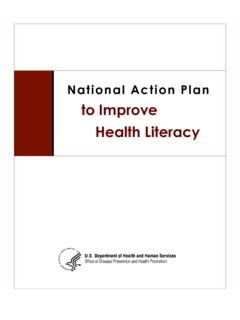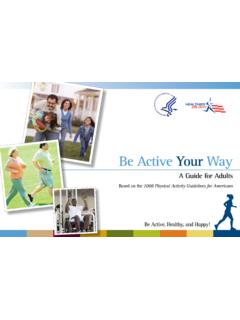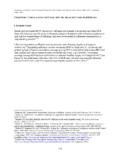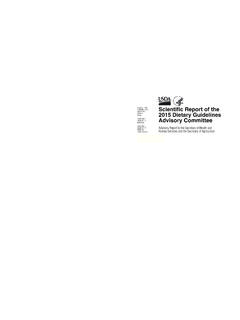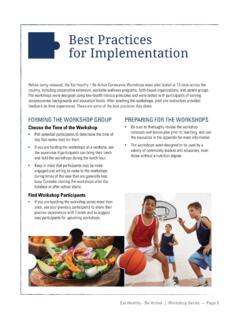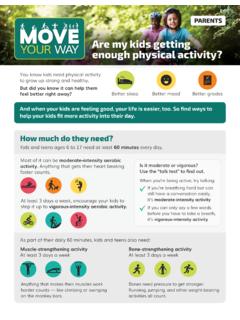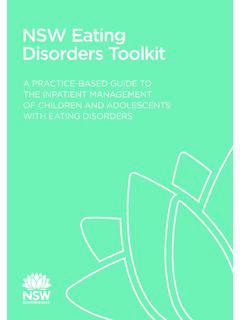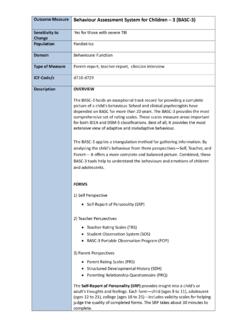Transcription of 2008 Physical Activity Guidelines for Americans - Health
1 Department of Health and Human Services 2008 Physical Activity Guidelines for Americans Be Active, Healthy, and Happy! THE SECRETARY OF Health AND HUMAN SERVICES WASHINGTON, 20201 I am pleased to present the 2008 Physical Activity Guidelines for Americans , the first comprehensive Guidelines on Physical Activity ever to be issued by the Federal government. This document is intended to be a primary source of information for policy makers, Physical educators, Health providers, and the public on the amount, types, and intensity of Physical Activity needed to achieve many Health benefits for Americans across the life span. The good news is that these Guidelines are achievable and can be customized according to a person s interests, lifestyle, and goals. This document is based on the report submitted by the Physical Activity Guidelines Advisory Committee, a group comprising 13 leading experts in the field of exercise science and public Health .
2 The committee conducted an extensive review of the scientific data relating Physical Activity to Health published since the release of the 1996 Surgeon General s Report on Physical Activity and Health . I want to thank the Committee and other public and private professionals who assisted in creating this document for their hard work and dedication. Along with President Bush, I believe that Physical Activity should be an essential component of any comprehensive disease prevention and Health promotion strategy for Americans . We know that sedentary behavior contributes to a host of chronic diseases, and regular Physical Activity is an important component of an overall healthy lifestyle. There is strong evidence that physically active people have better Health -related Physical fitness and are at lower risk of developing many disabling medical conditions than inactive people. Prevention is one of my top priorities.
3 Although Physical Activity is clearly vital to prevention, it is easy for many of us to overlook. These Physical Activity Guidelines for Americans provide achievable steps for youth, adults, and seniors, as well as people with special conditions to live healthier and longer lives. Sincerely, Michael O. Leavitt 2008 Physical Activity Guidelines for Americans ii Acknowledgments The Department of Health and Human Services (HHS) would like to recognize the efforts of the Physical Activity Guidelines Steering Committee that oversaw the work of the Physical Activity Guidelines Advisory Committee and the Physical Activity Guidelines writing group: Rear Admiral Penelope Slade Royall, PT, MSW (Office of Disease Prevention and Health Promotion; Director, Secretary s Prevention Priority).
4 Captain Richard P. Troiano, PhD (National Institutes of Health ; Physical Activity Guidelines Coordinator and Advisory Committee Executive Secretary); Melissa A. Johnson, MS (President s Council on Physical Fitness and Sports; Physical Activity Outreach Coordinator); Harold W. (Bill) Kohl III, PhD (Centers for Disease Control and Prevention (CDC); Physical Activity Science Coordinator until October 2007); and Janet E. Fulton, PhD (CDC; Physical Activity Science Coordinator beginning October 2007). The Department is grateful for the contributions of the HHS scientists and staff who participated in the Physical Activity Guidelines writing group that developed and created this document: David M. Buchner, MD, MPH (chair); Jennifer Bishop, MPH; David R. Brown, PhD; Janet E. Fulton, PhD; Deborah A. Galuska, PhD, MPH; Commander Julie Gilchrist, MD; Jack M. Guralnik, MD, PhD; Jennifer M. Hootman, PhD, ATC; Melissa A.
5 Johnson, MS; Harold W. (Bill) Kohl III, PhD; Sarah M. Lee, PhD; Kathleen A. (Kay) Loughrey, MPH, MSM; Judith A. McDivitt, PhD; Denise G. Simons-Morton, MD, PhD; Ashley Wilder Smith, PhD, MPH; Wilma M. Tilson, MPH; Captain Richard P. Troiano, PhD; Jane D. Wargo, MA; Gordon B. Willis, PhD; and the scientific writer/editor, Anne Brown Rodgers. The Department also gratefully acknowledges the work conducted by the 2008 Physical Activity Guidelines Advisory Committee. Their extensive review of the scientific literature on Physical Activity and Health and their committee deliberations are summarized in the Physical Activity Guidelines Advisory Committee Report, 2008. The Committee s report provided the basis for the 2008 Physical Activity Guidelines for Americans . The Advisory Committee consisted of William L. Haskell, PhD (chair); Miriam E. Nelson, PhD (vice-chair); Rod K. Dishman, PhD; Edward T.
6 Howley, PhD; Wendy M. Kohrt, PhD; William E. Kraus, MD; I-Min Lee, MBBS, ScD; Anne McTiernan, MD, PhD; Russell R. Pate, PhD; Kenneth E. Powell, MD, MPH; Judith G. Regensteiner, PhD; James H. Rimmer, PhD; and Antronette K. (Toni) Yancey, MD, MPH. The Department also acknowledges the important role of those who provided comments throughout the Physical Activity Guidelines development process. Finally, the Department appreciates the contributions of numerous other departmental scientists, staff, policy officials, and the external peer reviewers who reviewed the 2008 Physical Activity Guidelines for Americans and provided helpful suggestions. Acknowledgments iii Contents 2008 Physical Activity Guidelines for Americans Summary ..vi Key Guidelines for children and Adolescents .. vii Key Guidelines for Adults .. vii Key Guidelines for Older Adults .. vii Key Guidelines for Safe Physical Activity .
7 Viii Key Guidelines for Women During Pregnancy and the Postpartum Period .. viii Key Guidelines for Adults With Disabilities .. viii Key Messages for People With Chronic Medical Conditions .. viii A Roadmap to the 2008 Physical Activity Guidelines for Americans ..ix Chapter 1: Introducing the 2008 Physical Activity Guidelines for Americans ..1 Why and How the Guidelines Were Developed ..1 The Framework for the Physical Activity Guidelines for Americans ..2 Putting the Guidelines Into Practice ..5 Chapter 2: Physical Activity Has Many Health Benefits ..7 Examining the Relationship Between Physical Activity and The Health Benefits of Physical Activity ..9 Chapter 3: Active children and Adolescents ..15 Explaining the Guidelines ..16 Meeting the Guidelines ..18 Getting and Staying Active: Real-Life Examples ..19 Chapter 4: Active Adults ..21 Explaining the Guidelines .
8 21 Meeting the Guidelines .. 24 Special Considerations .. 25 Getting and Staying Active: Real-Life Examples .. 26 Chapter 5: Active Older Adults ..29 Explaining the Guidelines ..29 Meeting the Guidelines ..32 Special Considerations .. 32 Getting and Staying Active: Real-Life Examples ..34 2008 Physical Activity Guidelines for Americans iv Chapter 6: Safe and Active ..35 Explaining the Guidelines ..35 Gradually Increasing Physical Activity Over Time: Real-Life Examples .. 40 Chapter 7: Additional Considerations for Some Adults ..41 Physical Activity for Women During Pregnancy and the Postpartum Period ..41 Physical Activity for People With Disabilities .. 42 Physical Activity for People With Chronic Medical Conditions .. 43 Chapter 8: Taking Action: Increasing Physical Activity Levels of Americans ..45 What Can Adults Do To Get Enough Physical Activity ?.. 46 How Can We Help children and Adolescents Get Enough Physical Activity ?
9 46 What Can Communities Do To Help People Be Active? .. 48 Glossary ..51 Appendix 1. Translating Scientific Evidence About Total Amount and Intensity of Physical Activity Into Guidelines ..54 54 Two Methods of Assessing Aerobic Intensity .. 55 Developing Guidelines Based on Minutes of Moderate- and Vigorous-Intensity Activity ..55 Using Relative Intensity To Meet Guidelines Expressed in Terms of Absolute Intensity .. 56 Appendix 2. Selected Examples of Injury Prevention Strategies for Common Physical Activities and Sports ..58 Appendix 3. Federal Web Sites That Promote Physical Activity ..60 Individuals and Families .. 60 Schools .. 60 Communities .. 60 Health Care ..61 Worksites ..61 Contents v 2008 Physical Activity Guidelines for Americans Summary Being physically active is one of the most important steps that Americans of all ages can take to improve their Health .
10 The 2008 Physical Activity Guidelines for Americans provides science-based guidance to help Americans aged 6 and older improve their Health through appropriate Physical Activity . The Department of Health and Human Services (HHS) issues the Physical Activity Guidelines for Americans . The content of the Physical Activity Guidelines complements the Dietary Guidelines for Americans , a joint effort of HHS and the Department of Agriculture (USDA). Together, the two documents provide guidance on the importance of being physically active and eating a healthy diet to promote good Health and reduce the risk of chronic diseases. The primary audiences for the Physical Activity Guidelines are policymakers and Health professionals. These Guidelines are designed to provide information and guidance on the types and amounts of Physical Activity that provide substantial Health benefits.

